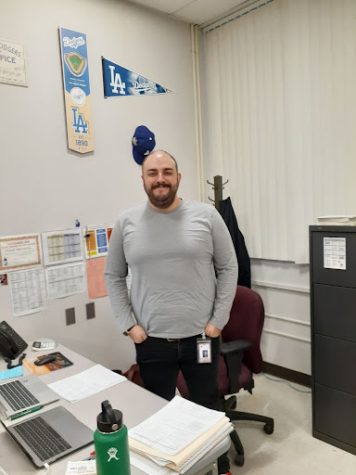Cordova High confronts sliding graduation rate

Cordova High principal Jared Hyden. Photo by Maxim Russu, Cordova High.
January 2, 2023
For the past five-plus years, the graduation rate has been dropping at Cordova High School – something that concerns CHS administrators and teachers.
According to the Public School Review website, the CHS graduation rate has fallen from a peak of nearly 95 percent in 2015 to 90 percent in 2021. Although this is still above the state average of 84 percent, school officials say the number is worrying.
(https://www.publicschoolreview.com/cordova-high-school-profile/95670)
Jared Hyden has been the principal at CHS for five years and he is most worried about students who feel detached and disconnected.
“I don’t think that there are things that make people want to drop out, I think that there (are) things that keep people connected,” Hyden said. “And when you have a lack of connection, whether it be through sports or clubs (or other activities)… I think those contributing factors are what ultimately lead people to drop out…”
A lack of connection, according to Hyden, can reduce a student’s drive and motivation, which helps produce higher dropout rates.
The question for school leaders, Hyden said, is how “do we reconnect that student with their school and with their community so that we provide them options, because options can help prevent dropouts.”
Frank Murrieta teaches all levels of math at CHS and expressed concerns similar to Hyden’s.
“Whether it be in extracurricular activities or in a classroom with their peers and their teachers, if they don’t feel like school is a place where they feel comfortable, then that is something that could lead to someone considering dropping out,” Murrieta said.
To help students who struggle with their learning, the school provides after-school activities, including extensive tutoring and clubs such as “math-letes.” The goal is to provide more ways for students to connect with peers and adults on campus.
“I mean if students don’t have people that they are able to connect with, whether that be staff or peer students,” Murrieta said, “then it’s easy for them to feel like an outsider and maybe consider dropping out.”
Murrieta said he believes that, for some, the drive to graduate and not drop out revolves around going to college, meeting friends or to escape their life circumstances. The motivation varies from person to person, he said.
English teacher Jonathan Tees, who teaches ninth and 10th grade classes, said his main concern is students who are counting their days until they drop out – and he’s trying to help them view school differently.
“One of the convictions I have as a teacher is trying to get students to see education as having value in itself,” Tees said. “It doesn’t necessarily have a value of just ‘getting me a job,’ but it’s good for me to do it because it expands my mind, introduces me to other cultures, gets me to think about interesting and different topics – and all of those can be very rich for the student.”
There are multiple factors that determine students’ perception of the value of school, Tees said.

“It can be a confidence thing, psychological or emotional,” Tees said. But he added some students have an inaccurate view of what school can do for them.
Hyden said, as principal, he’s trying to make sure the entire Cordova High community is doing everything possible to help every student succeed.
“The most important thing we’re trying to do is make sure that we are showing up as staff, and as teachers, and teaching and doing our best, every single day,” Hyden said.
To achieve that goal, it’s important to identify which students are struggling the most, including English language learners, socioeconomically disadvantaged students and other subgroups.
“We’re trying to do a number of different connection pieces between our clubs and sports,” Hyden said.
Another key contributor to faltering performance and dropping out, said Hyden, is the reduced attendance that can come with a lack of connection.
Among the resources the school provides are specialists who promote student engagement and academic advisers who are in contact with students and their families at home, making sure there are plans in place for students that will help them keep moving toward graduation.
“It absolutely has an impact,” Hyden said. “As a staff, we need to keep that in mind … we have lots of people that can connect and try to align some of the resources. But we have to make sure kids are aware of those resources, and like I said, we have to work to get kids to class and to school for them to take advantage of those resources.”
